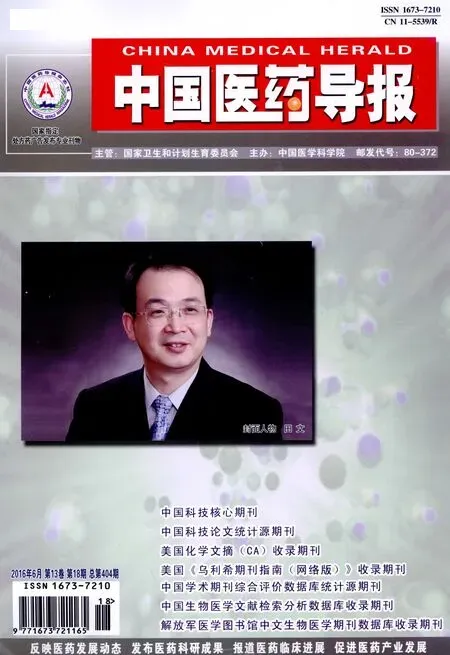分子探针在磁共振成像靶向检测肿瘤中的应用进展
周代兵 许国雄复旦大学附属金山医院中心实验室,上海201508
分子探针在磁共振成像靶向检测肿瘤中的应用进展
周代兵许国雄
复旦大学附属金山医院中心实验室,上海201508
分子影像学利用肿瘤微环境中特异性生物靶点的分子探针,借助磁共振分子成像超高空间分辨率、靶向性强等优点,能够较好地获取肿瘤三维解剖结构及生理、病理等信息,可为肿瘤早期、精准诊断和治疗提供重要的参考依据。
磁共振成像;肿瘤微环境;生物靶点;分子探针;早期诊断
1999年Weissleder等[1]提出分子影像学的概念,基本原理是以携载配体的分子探针和体内靶分子(核酸或蛋白质[2])特异性结合,通过磁共振图像准确地显示细胞或分子水平的病理生理过程。肿瘤微环境中的代谢、免疫和内分泌改变影响着肿瘤的发生发展。针对微环境中新生血管内皮细胞和肿瘤细胞上高表达的特异性受体,合成靶向性分子探针,输注并与体内受体特异性结合,从微观分子层面上解读肿瘤的发生发展及其结构特征[3]。本文就分子探针在磁共振靶向检测肿瘤方面的应用进展予以综述。
1 肿瘤磁共振分子探针概述
肿瘤靶向性分子探针由靶向性配体、转运体和对比剂三部分组成[4],为实现机体内目标靶点的特异性显影,这就要求分子探针在体内具有放大效应、较强的穿透能力、较长的半衰期以及较快的排出能力,而靶分子具有高分泌或者高表达、高亲和力等特点,并且能很好地代表靶点生物特性。
常用的分子探针按成像材料可分为两大类:一类是以钆(gadolinium,Gd)和锰(manganese,Mn)元素为基础的顺磁性对比剂,在T1弥散加权成像(T1WI)上表现为高信号;另一类是含有或包裹氧化铁的超顺磁性对比剂,在T2WI上表现为低信号[5]。
1.1钆类分子探针
钆类对比剂是一种顺磁性物质,具有7个不成对电子。不成对电子在磁场作用下产生较大的磁场波动,使得组织纵向(T1)与横向(T2)弛豫时间缩短,从而改变组织的磁共振信号。钆浓度在临床剂量内(约0.1 mmol/kg),以影响T1弛豫时间为主,用于T1WI[6]。当钆对比剂使用超过临床剂量时,T2的增强作用超过T1增强作用,在部分组织中T1WI显示为低信号,称之为阴性造影[7]。但有研究发现,对于肾功能不全患者(除急性肾损伤外),特别是肾小球滤过率小于30mL/(min·1.73m2)的患者,钆对比剂剂量加大会加重肾功能损害[8]。目前临床上应用的钆螯合物对比剂Gd-DTPA(MagnevistR)及Gd-DOTA(DotaremR)等为离子型非特异性细胞外液对比剂,因具有非特异性分布、化学毒性、检查剂量高、滞留时间长等不足,限制了其在临床上的广泛应用。
自Ehrlich提出药物靶向治疗的设想[9],其理念便被迅速运用到磁共振靶向检测领域,且在肿瘤领域广泛应用。根据肿瘤组织器官特点,磁共振靶向可分为被动和主动两种方式。被动靶向是根据肿瘤所在组织器官的病理生理特性,设计粒子直径大小合适、特异性高的钆螯合物对比剂,使分子探针在特定细胞内凝聚并识别靶点,其中就包括针对Kupffer细胞的钆类对比剂,主要应用在肝脏系统,能鉴别肝细胞来源肿瘤和正常肝组织[10]。肿瘤高通透性和滞留效应亦是肿瘤被动靶向成像的因素之一。Betancourt等[11]根据这一原理设计含钆类高分子化合物的纳米颗粒对比剂,发现其可以在乳腺癌部位高度聚集,从而区分乳腺癌组织和正常组织。
肿瘤主动方式主要是借助机体内配体和受体特异性结合原理[12]。靶点可为肿瘤细胞、肿瘤血管或间质细胞。Zhang等[13]将羟基化纳米中孔二氧化硅(hydroxylated mesoporous nano-silica,HMNS)涂覆聚乙烯亚胺再加钆和叶酸,可以显著增强磁共振对比效果;加上叶酸能特异地与乳腺癌细胞表面上的叶酸受体结合,使得整个系统具有很高的靶向性能。
将荧光探针与钆剂整合于同一分子探针中,也可用于肿瘤迁移、侵袭功能成像的基础研究;特异性干扰基因或药物与钆剂构建于同一体系内,使其具备诊断和治疗一体化。当前,有学者将钆类分子探针应用于肿瘤靶向药物的疗效评估[14],引起了许多研究者的注意。
1.2锰类分子探针
锰也是一种顺磁性金属,二价锰具有比较好的T1弛豫增强效果。相比其他对比剂,锰对比剂种类多样化,锰离子螯合物在生物学上是钙离子的类似物,它本身就具有分子探针的特性[15]。
锰福地匹三钠(mangafodipir trisodium,Mn-DPDP)由Mn2+和2个磷酸吡哆醛基对称性螯合而成,被肝脏摄取后,与胞内功能蛋白分子相互作用,结构异构化,使其T1明显缩短,从而使肝组织特异性显影,能够有效鉴别诊断肝脏病变[16-17]。
将顺磁性锰离子与纳米粒子结合起来制备探针具有稳定性好、易于化学修饰、生物兼容性好、可药物靶向传递等特点。Chen等[18]制备包裹有多柔比星的二氧化硅涂层的中孔空心氧化锰纳米粒子对比剂,在小鼠肝脏中T1像增强效果明显,此种复合锰对比剂在体内还具有药物传递的优点。
1.3超氧化铁类分子探针
含铁金属纳米颗粒粒径小,易观察,且可塑性大,弛豫率高。近年来,高温热分解法制备磁性纳米晶体较为常用,高温下合成的纳米粒子具有良好的生物特性、磁反应性和兼容性,副作用轻。目前常用的磁性氧化铁纳米颗粒探针主要分为粒径大小在50 nm以上的超顺磁氧化铁纳米粒子(super-small particle of iron oxide nanparticles,SPIONs)和粒径在50 nm以下的超微顺磁氧化铁纳米粒子(ultrasmall particle of iron oxide nanoparticles,USPIONs)[19]。SPIONs对比剂缩短T2时间远远超过其缩短T1时间的效应,主要用于T2WI增强扫描;USPIONs对比剂缩短T1时间效应比SPIONs显著,故常用于T1WI增强扫描[20]。
新型的超顺磁性纳米探针,多在原SPIONs基础上通过纳米颗粒表面靶向性结合配体,如蛋白质[21]、多肽[22]、小分子物质(如叶酸[23]、糖类[24])等,与体内组织细胞受体特异性结合,在微观水平上辅助肿瘤诊断。Ma等[25]将叶酸修饰到SPIONs表面制备成叶酸-SPIONs靶向探针,显著提高肿瘤对叶酸-SPIONs的摄取,从而提高MRI对肿瘤的检出率。在一项研究中[26],SPIONs涂覆葡聚糖(DSPIONs)并与铃蟾肽(BBN)结合形成靶向对比剂,结果显示,DSPION-BBN结合T47D乳腺癌细胞,能够检测出过度胃泌素释放肽受体的靶向能力。
针对表皮生长因子[27]、αvβ3整合素、ERK和AKT信号通路等信号受体,制备携带有超氧化铁的分子探针,在肿瘤早期诊断与鉴别方面有着巨大优势[28-29]。Melemenidis等[30]利用环状精氨酸-甘氨酸-天冬氨酸(RGD)与USPION偶联,检测表达于肿瘤活化血管内皮细胞表面的αvβ3整合素。RGD-USPIONs可直观显示肿瘤血管内皮αvβ3整合素活化型的表达情况。
2 总结与展望
磁共振分子探针技术可以在细胞未出现结构改变的超早期从分子层面探测到疾病的变化,从而使活体内微环境改变导致疾病发生发展的动态过程研究成为可能。
钆类对比剂在体内长期滞留有可能造成肾源性系统性纤维化(nephrogenic systemic fibrosis,NSF)[31],锰螯合物对比剂在高浓度使用时会引起大脑基底节、黑质等神经系统不可逆损害以及以铁离子为基础的磁共振分子探针表面修饰复杂、颗粒形状不规则、制备参数难控等不足,影响着三类对比剂在临床的广泛使用。因此,还需进一步优化对比剂的制备参数和生物特性,以减轻临床毒副作用。
新型的超氧化铁类纳米探针更加注重特定的生物亲和力及靶向性,减少对非靶点部位的影响。新型纳米铁探针也正快速向包括贵金属纳米颗粒、纳米碳管、富勒烯等领域拓展。
目前各类纳米探针表面化学性质、偶联配体生物活性、显像效果、生物安全性等诸多因素影响着临床进一步的应用。动物研究成果转向临床还需要深入研究,而多模态成像联合核素显像、光学成像、等分子影像技术相互取长补短,对实现不同模式下的多重显像具有重要的现实意义,而分子探针在这一领域有着巨大的发展潜力。
[1]Weissleder R,Tung CH,Mahmood U,et al.In vivo imaging of tumors with protease-activated near-infrared fluorescent probes[J].Nat Biotechnol,1999,17(4):375-378.
[2]Liu CH,Ren JQ,Yang J,et al.DNA-based MRI probes for specific detection of chronic exposure to amphetamine in living brains[J].JNeurosci,2009,29(34):10663-10670.
[3]Jun HY,Yin HH,Kim SH,et al.Visualization of tumor angiogenesis using MR imaging contrast agent Gd-DTPA-anti-VEGF receptor 2 antibody conjugate in amouse tumormodel[J].Korean JRadiol,2010,11(4):449-456.
[4]Tan M,Burden-Gulley SM,Li W,et al.MR molecular imaging of prostate cancer with a peptide-targeted contrast agent in amouse orthotopic prostate cancermodel[J]. Pharm Res,2012,29(4):953-960.
[5]Liu W,Dahnke H,Rahmer J,et al.Ultrashort T2*relaxometry for quantitation of highly concentrated superparamagnetic iron oxide(SPIO)nanoparticle labeled cells[J].Magn Reson Med,2009,61(4):761-766.
[6]Cao L,Li B,Yi P,et al.The interplay of T1-and T2-relaxation on T1-weighted MRI of hMSCs induced by Gd-DOTA-peptides[J].Biomaterials,2014,35(13):4168-4174.
[7]Chan JH,Tsui EY,Yuen MK,et al.Gadopentetate dimeglumine as an oral negative gastrointestinal contrast agent for MRCP[J].Abdom Imaging,2000,25(4):405-408.
[8]Kitajima K,Maeda T,Watanabe S,et al.Recent topics related to nephrogenic systemic fibrosis associated with gadolinium-based contrastagents[J].Int JUrol,2012,19(9):806-811.
[9]Silverstein AM.The collected papers of Paul Ehrlich:why was volume 4 never published?[J].Bull HistMed,2002,76(2):335-339.
[10]Ni Y,Chen F,Wang H,et al.Proper definitions of MRI contrast enhancement in liver tumors[J].JGastroenterol,2010,45(3):349-352.
[11]Betancourt T,Shah K,Brannon-Peppas L.Rhodamineloaded poly(lactic-co-glycolic acid)nanoparticles for investigation of in vitro interactions with breast cancer cells[J].JMater SciMater Med,2009,20(1):387-395.
[12]Caravan P.Protein-targeted gadolinium-based magnetic resonance imaging(MRI)contrastagents:design andmechanism ofaction[J].Acc Chem Res,2009,42(7):851-862.
[13]Zhang G,Gao J,Qian J,et al.Hydroxylated mesoporous nanosilica coated by polyethylenimine coupled with gadolinium and folic acid:a tumor-targeted T1 magnetic resonance contrast agent and drug delivery system[J]. ACSAppl Mater Interfaces,2015,7(26):14192-14200.
[14]Gupta A,de Campo L,Rehmanjan B,et al.Evaluation of Gd-DTPA-monophytanyl and phytantriol nanoassemblies aspotentialMRIcontrastagents[J].Langmuir,2015,31(4):1556-1563.
[15]Tan W,Barnett JV,Hehn GM,et al.Effect ofmanganese(Ⅱ)bis(glycinate)dichloride on Ca2+channel function in cultured chick atrialcells[J].Toxicology,1991,68(1):63-73.
[16]van Beers BE,Daire JL,Garteiser P.New imaging techniques for liver diseases[J].JHepatol,2015,62(3):690-700.
[17]Rockall AG,Planche K,Power N,et al.Detection of neuroendocrine liver metastases with MnDPDP-enhanced MRI[J].Neuroendocrinology,2009,89(3):288-295.
[18]Chen Y,Chen H,Zhang S,et al.Structure-property relationships in manganese oxide--mesoporous silica nanoparticles used for T1-weighted MRI and simultaneous anti-cancer drug delivery[J].Biomaterials,2012,33(7):2388-2398.
[19]Hoffman D,Sun M,Yang L,et al.Intrinsically radiolabelled[(59)Fe]-SPIONs for dual MRI/radionuclide detection[J].Am JNuclMed Mol Imaging,2014,4(6):548-560.
[20]Matuszewski L,Tombach B,Heindel W,et al.Molecular and parametric imagingwith ironoxides[J].Radiologe,2007,47(1):34-42.
[21]Sakulkhu U,Mahmoudi M,Maurizi L,et al.Significance of surface charge and shellmaterial of superparamagnetic iron oxide nanoparticle(SPION)based core/shell nanoparticles on the composition of the protein corona[J].Biomater Sci,2015,3(2):265-278.
[22]Muthiah M,Park IK,Cho CS.Surface modification of iron oxide nanoparticles by biocompatible polymers for tissue imagingand targeting[J].Biotechnol Adv,2013,31(8):1224-1236.
[23]Tang Q,An Y,Liu D,et al.Folate/NIR 797-conjugated albumin magnetic nanospheres:synthesis,characterisation,and in vitro and in vivo targeting evaluation[J].PLoS One,2014,9(9):e106483.
[24]Zhang W,Chen Y,Guo DJ,et al.The synthesis of a D-glucosamine contrast agent,Gd-DTPA-DG,and its application in cancermolecular imaging with MRI[J].Eur J Radiol,2011,79(3):369-374.
[25]Ma X,Gong A,Chen B,et al.Exploring a new SPION-based MRI contrast agent with excellent water-dispersibility,high specificity to cancer cells and strong MR imaging efficacy[J].Colloids Surf B Biointerfaces,2015,126:44-49.
[26]Jafari A,Salouti M,Shayesteh SF,et al.Synthesis and characterization of Bombesin-superparamagnetic iron oxide nanoparticles as a targeted contrast agent for imaging of breast cancer using MRI[J].Nanotechnology,2015,26(7):75101.
[27]Bharde AA,Palankar R,Fritsch C,et al.Magnetic nanoparticles as mediators of ligand-free activation of EGFR signaling[J].PLoSOne,2013,8(7):e68879.
[28]Huang X,Yi C,Fan Y,et al.Magnetic Fe(3)O(4) nanoparticles grafted with single-chain antibody(scFv)and docetaxel loaded beta-cyclodextrin potential for ovarian cancer dual-targeting therapy[J].Mater SciEng C Mater Biol Appl,2014,42:325-332.
[29]Shahbazi-Gahrouei D,Abdolahi M.Detection of MUC1-expressing ovarian cancer by C595 monoclonal antibodyconjugated SPIONs using MR imaging[J].ScientificWorld Journal,2013,2013:609151.
[30]Melemenidis S,Jefferson A,Ruparelia N,et al.Molecular magnetic resonance imaging of angiogenesis in vivo using polyvalent cyclic RGD-iron oxide microparticle conjugates[J].Theranostics,2015,5(5):515-529.
[31]Haylor J,Schroeder J,Wagner B,et al.Skin gadolinium following use of MR contrast agents in a rat model of nephrogenic systemic fibrosis[J].Radiology,2012,263(1):107-116.
App lication progress of molecular probes in magnetic resonance im aging targeting detection for the tumor
ZHOU Daibing XU Guoxiong
Central Laboratory,Jinshan Hospital of Fudan University,Shanghai 201508,China
Molecular imaging utilizes themolecular probes designed to bind to the targets in the tumor environment along with the magnetic resonance imaging,enabling the visualization of three-dimensional anatomical pictures,pathophysiological features,and other important information of the tumor.Therefore,it can be used as a vital tool for the early and precise diagnosis and treatment of cancer.
Magnetic resonance imaging;Tumor microenvironment;Biological target;Molecular probe;Early detection
R445.5;R73
A
1673-7210(2016)06(c)-0046-04
周代兵(1989.4-),男,复旦大学上海医学院2014级肿瘤学专业在读硕士研究生;研究方向:肿瘤细胞分子生物学。
许国雄(1960.7-),男,研究员,博士生导师,复旦大学附属金山医院中心实验室主任;研究方向:肿瘤细胞分子生物学。
(2016-02-03本文编辑:张瑜杰)

